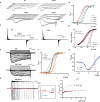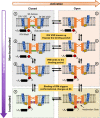A mechanistic reinterpretation of fast inactivation in voltage-gated Na+ channels
- PMID: 37604801
- PMCID: PMC10442390
- DOI: 10.1038/s41467-023-40514-4
A mechanistic reinterpretation of fast inactivation in voltage-gated Na+ channels
Abstract
The hinged-lid model was long accepted as the canonical model for fast inactivation in Nav channels. It predicts that the hydrophobic IFM motif acts intracellularly as the gating particle that binds and occludes the pore during fast inactivation. However, the observation in recent high-resolution structures that the bound IFM motif is located far from the pore, contradicts this preconception. Here, we provide a mechanistic reinterpretation of fast inactivation based on structural analysis and ionic/gating current measurements. We demonstrate that in Nav1.4 the final inactivation gate is comprised of two hydrophobic rings at the bottom of S6 helices. These rings function in series and close downstream of IFM binding. Reducing the volume of the sidechain in both rings leads to a partially conductive, leaky inactivated state and decreases the selectivity for Na+ ion. Altogether, we present an alternative molecular framework to describe fast inactivation.
© 2023. Springer Nature Limited.
Conflict of interest statement
The authors declare no competing interests.
Figures








Update of
-
A Mechanistic Reinterpretation of Fast Inactivation in Voltage-Gated Na + Channels.bioRxiv [Preprint]. 2023 Apr 28:2023.04.27.538555. doi: 10.1101/2023.04.27.538555. bioRxiv. 2023. Update in: Nat Commun. 2023 Aug 21;14(1):5072. doi: 10.1038/s41467-023-40514-4. PMID: 37162849 Free PMC article. Updated. Preprint.
-
A Mechanistic Reinterpretation of Fast Inactivation in Voltage-Gated Na+ Channels.Res Sq [Preprint]. 2023 May 22:rs.3.rs-2924505. doi: 10.21203/rs.3.rs-2924505/v1. Res Sq. 2023. Update in: Nat Commun. 2023 Aug 21;14(1):5072. doi: 10.1038/s41467-023-40514-4. PMID: 37292679 Free PMC article. Updated. Preprint.
Similar articles
-
A Mechanistic Reinterpretation of Fast Inactivation in Voltage-Gated Na+ Channels.Res Sq [Preprint]. 2023 May 22:rs.3.rs-2924505. doi: 10.21203/rs.3.rs-2924505/v1. Res Sq. 2023. Update in: Nat Commun. 2023 Aug 21;14(1):5072. doi: 10.1038/s41467-023-40514-4. PMID: 37292679 Free PMC article. Updated. Preprint.
-
A Mechanistic Reinterpretation of Fast Inactivation in Voltage-Gated Na + Channels.bioRxiv [Preprint]. 2023 Apr 28:2023.04.27.538555. doi: 10.1101/2023.04.27.538555. bioRxiv. 2023. Update in: Nat Commun. 2023 Aug 21;14(1):5072. doi: 10.1038/s41467-023-40514-4. PMID: 37162849 Free PMC article. Updated. Preprint.
-
A sodium channel mutant removes fast inactivation with the inactivation particle bound.J Gen Physiol. 2025 Jan 6;157(1):e202413667. doi: 10.1085/jgp.202413667. Epub 2024 Nov 27. J Gen Physiol. 2025. PMID: 39601860 Free PMC article.
-
Functional roles of cytoplasmic loops and pore lining transmembrane helices in the voltage-dependent inactivation of HVA calcium channels.J Physiol. 2004 Jan 15;554(Pt 2):263-73. doi: 10.1113/jphysiol.2003.047068. Epub 2003 Jun 18. J Physiol. 2004. PMID: 12815185 Free PMC article. Review.
-
Emerging issues of connexin channels: biophysics fills the gap.Q Rev Biophys. 2001 Aug;34(3):325-472. doi: 10.1017/s0033583501003705. Q Rev Biophys. 2001. PMID: 11838236 Review.
Cited by
-
A binding site for phosphoinositides described by multiscale simulations explains their modulation of voltage-gated sodium channels.Elife. 2024 Mar 11;12:RP91218. doi: 10.7554/eLife.91218. Elife. 2024. PMID: 38465747 Free PMC article.
-
Nav1.2 channel mutations preventing fast inactivation lead to SCN2A encephalopathy.Brain. 2025 Jan 7;148(1):212-226. doi: 10.1093/brain/awae213. Brain. 2025. PMID: 38939966 Free PMC article.
-
Closed State Structure of the Pore Revealed by Uncoupled Shaker K+ Channel.Res Sq [Preprint]. 2025 May 9:rs.3.rs-6406486. doi: 10.21203/rs.3.rs-6406486/v1. Res Sq. 2025. PMID: 40386396 Free PMC article. Preprint.
-
Conformational photo-trapping in NaV1.5: Inferring local motions at the "inactivation gate".Biophys J. 2024 Jul 16;123(14):2167-2175. doi: 10.1016/j.bpj.2024.04.017. Epub 2024 Apr 24. Biophys J. 2024. PMID: 38664963 Free PMC article.
-
Biophysical mechanisms of myocardium sodium channelopathies.Pflugers Arch. 2024 May;476(5):735-753. doi: 10.1007/s00424-024-02930-3. Epub 2024 Mar 1. Pflugers Arch. 2024. PMID: 38424322 Review.
References
-
- Hille, B. Ion Channels of Excitable Membranes. 3rd ed. (Sinauer Associates, 2001).
-
- Noda M, et al. Primary structure of Electrophorus electricus sodium channel deduced from cDNA sequence. Nature. 1984;312:121–127. - PubMed
Publication types
MeSH terms
Substances
Grants and funding
LinkOut - more resources
Full Text Sources

